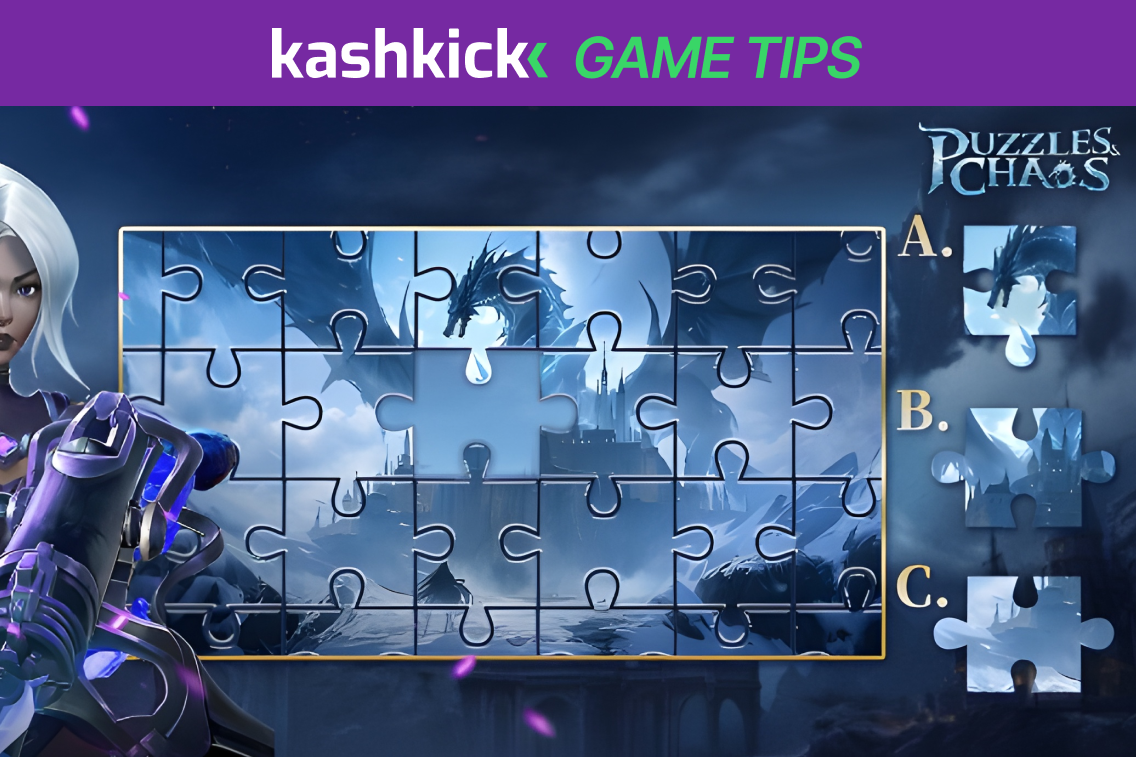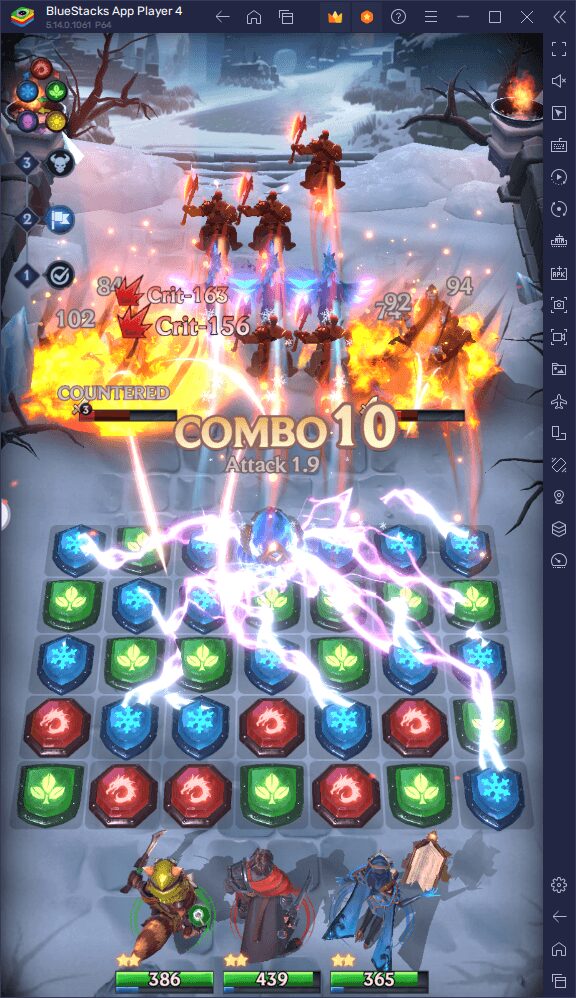
Last Updated on April 21, 2025 by KashKick Crew
What is Puzzles & Chaos: Frozen Castle?
Puzzles & Chaos: Frozen Castle is a strategy role-playing game with match 3 elements. Your goal in the game is to defeat demons and expand your territory in a frozen wasteland. The main aspects of the game in terms of gameplay are expanding and upgrading your bases while increasing your power to defeat enemies using match 3 puzzles.
The Aesthetic and Setting of Puzzles & Chaos: Frozen Castle
The setting takes place in a fantasy medieval-esque land that has frozen over. You take the place of a lord who rules a kingdom and must rebuild and expand your land while dealing with the demons who live in the frozen wasteland. The game has family-friendly themes with little mention of blood or extreme violence–so it’s a good game to potentially even enjoy with young family members.
The Resource System of Puzzles & Chaos: Frozen Castle
Puzzles & Chaos: Frozen Castle has a fairly simple resource system–but it’s important to know what each resource does in terms of player progression.
Food and Wood – Food and wood are the two basic materials players will need early in the game. This can be used to upgrade buildings, recruit units, and do research to increase your stats in combat, economy, development, and defense. You can acquire wood from lumberyards and food from farms.
Stone – Stone is similar to food and wood as it acts as one of the basic materials that can upgrade most buildings. However, it’s unique. Stone is a resource which is typically used in higher level buildings and units, so while you might acquire items that give you stone, you won’t be able to actively earn until later in your progression.
Diamonds – Diamonds are the game’s paid currency; however, players have ways of obtaining this resource through events, quests, and milestones. The main two ways this currency is used are to buy exp for your VIP (which gives benefits the higher level it is) or to speed up building progression instantly.

Puzzles & Chaos: Frozen Castle Combat
The game has two major forms of combat, one of which is more passive and uses units and hero power and the other is more active, using match 3 and classic RPG elements in a wonderful combination that makes for very interesting and tactical gameplay. I’ll explain both and their underlying systems.
Match 3 Combat- This form of combat is used in Adventure mode (known as the Mesdi portal), Arena, Alliance expeditions, and Castle expeditions. Match 3 elements are utilized in this mode for attacking as each successful match launches powerful attacks at the enemy. It will launch elemental troops created by the element that the titles were when they matched. This means that your attacks can actually miss despite getting a successful match if the enemy you’re trying to hit isn’t in the row. It’s important to note that enemies typically are big enough to fit two rows, while bosses will typically be 3 rows.
The game has 5 different elements which are Fire, Ice, Nature, Light, and Dark. These are both the elements enemies have, but also the elements that your heroes will have.
It’s important to note that if you don’t have a certain element of hero on your team, matches of that element will not damage the enemy. This is due to the power of matches being based off the heroes of the matching element.
Elements also have strengths against certain elements but will typically be weak against another type of element.
Fire– Weak against ice, strong against nature
Nature– Weak against fire, strong against ice
Ice– Weak against nature, strong against fire
Dark– Strong and weak against light
Light– Strong and weak against dark
Attacking enemies with the same element will result in neutral damage.
When choosing a hero composition, it is also important to remember that each hero has unique abilities that they can use in combat. Some of the heroes have supportive abilities–others have damaging abilities that can either do single target damage or AOE damage to multiple foes. You can cast abilities by gathering rage, which is gained when pieces are matched. The rage gain is doubled if the attacks miss the enemy.
In combat, enemies will gain rage whenever your matched attacks attack them. They will not gain rage, however, when your heroes directly attack them through their rage attacks.
Enemies will also gain rage over time through turns passing. This means while you can avoid directly attacking the enemy for them to gain rage, they will eventually still gain their ability either way. These attacks can be devastating, so it’s best to have a defensive unit to protect your team when they happen.
Unit combat- This combat is used when the player engages in Alliance wars, Pillaging, and combat on the world map. It is a very passive form of combat that doesn’t use animations or active gameplay, but still important to keep in mind when doing this form of combat.
While heroes are also used in this form of combat, it’s generally carried by units, which the player can recruit. There are four times of units:
Infantry– Weak against calvary, strong against archers and vehicles
Archers – Weak against infantry, strong against calvary and vehicles
Calvary– Weak against archers, strong against infantry and vehicles
Vehicles- Weak against everything, Strong against player defenses (such as walls)
The Puzzles & Chaos: Frozen Castle Community
The community for Puzzles & Chaos is fairly active, especially in the game community. You can find alliances quite easily by either applying or joining one that allows anyone to join (though those will most likely not be anywhere near as active). The game also has a realm chat where you can talk to other players on your server, and they’d be quite helpful in that chat as well.
My Experience Playing Puzzles & Chaos: Frozen Castle
In general, my experience playing Puzzles & Chaos was quite interesting, and definitely introduced me to some new concepts for the genre. I’ll go over my experience playing the game and give some tips to potentially help your gameplay as well.
Downloading and Starting a New Game
To download the game, I simply followed the link from the Kashkick app. Downloading the game didn’t take long at all and was a fairly fast process that only took roughly 6 minutes, which is pretty fast. This also activates your KashKick offer to make sure you get paid to play.
The loading screen had beautiful art, which immediately pulled me into the fantasy world. Once the download finished, I was taken into the gameplay.
General Gameplay for Puzzles & Chaos
When the game opens, it immediately takes you into a voice-acted tutorial, which is pretty immersive. It then teaches you about the aspects of the match 3 combat, including what each match does and how it will cause you to attack your opponent.
Eventually, we defeated the tutorial enemy, and I was led to create the Citadel, which is the main building for the game that dictates most of your progression. The game did well to teach why each and every aspect was important. In general, the entirety of the tutorial was helpful and valuable.
As I built more buildings and progressed, I noticed that the game gave some resources for free, but unlike other games. The free resources I received were enough to help me spend some money on the game, which I found useful early on.
I feel like I made reasonable progress at around 5 hours in, and I started to unlock higher-tier units and new resources. That was a good feeling and made me feel there was more to explore inside of the game, which is quite rare for the genre after a certain point in gameplay. I felt genuinely great about playing the game and making progress–which was also nice for keeping track of my KashKick goals.
Spending money in the game felt good and definitely helped my progression, though I personally recommend spending it early on as I regret not doing so myself.

Strategies I Personally Use and Recommend
There are certain things you can do in the game that can make your adventure much smoother, especially if you want to aim for faster progress for your Kashkick goal. I’ll go over some of what I did and what I personally recommend doing to maximize your experience.
In-app Purchases
When it comes to in-app purchases in this game, there are two very different mindsets you can go into it with. Both mindsets have come from my time playing, and I noticed things I wish I’d bought that would’ve made my experience easier and faster.
Buy early to make progression smoother: I wish I had followed this thought process. Many of the deals you get early on are very fair for the price, and buying multiple deals will greatly improve your experience. I highly suggest that if you enjoy the game and want to progress faster for KashKick rewards, you prepare for some in-app purchases–it pays off.
Go free-to-play and converse your resources: This might be controversial, but this game is actually quite nice for free-to-play players. The deals in this game are also more expensive in general than other games, so this could be ideal for players who have more time than money. Most of the content in the game can be done without paid units, though they do make things easier and faster.
Keeping Track of Events
Events in this game are easy to keep track of, but it’s essential to keep track of them, nonetheless. The game will typically have an exclamation point whenever you have a reward ready on the event icon to let you know to claim it. When you see this, I highly suggest going ahead and grabbing your reward to make sure you keep your progress going.
Joining an Alliance
Alliances are extremely important to join as early as possible for multiple reasons.
One primary reason is that alliances can help speed up the progress of buildings by a decent margin. You’ll mostly only notice the boost early on, so it’s important to use it as early as possible. Alliances also provide tons of rewards in general, as well as additional content for players to have fun with.

Summary
Puzzles & Chaos: Frozen Castle is a fun game with a very unique perspective on the RPG genre. It’s definitely worth trying and exploring the unique gameplay. It also has good deals for new players. It provides fair deals for spenders and fair rewards for free-to-play players. A great game to play while earning extra kash.
